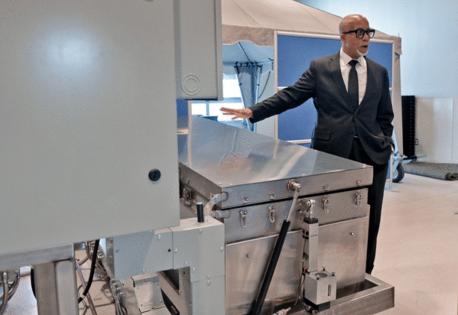A Baltimore mortician is performing water cremation -- before regulations are in place
Published in News & Features
BALTIMORE — It’s almost like a washing machine, if you ask Joseph H. Brown. The casket-shaped metal tank sitting in Brown’s crematory in West Baltimore uses hot water, chemicals and a bit of agitation to dissolve human remains, leaving behind only bone.
The practice, formally known as alkaline hydrolysis, was legalized during this year’s General Assembly session. But the state Board of Morticians and Funeral Directors is still writing the regulations that will govern the practice in Maryland, according to its director. There’s a law on the books, but no regulation, creating what may be a legal gray area for performing the procedure.
Brown, who installed his system in April, said he hasconducted water cremation. He believes he’s the first to do so in the state. He charges $5,000 for it, compared to $1,700 for a traditional flame cremation.
“My mother, who is 94-years-old, she says — joking — ‘Why would anybody pay more for alkaline hydrolysis?’” Brown said. “Let me answer that for you: Some people drive a Mercedes and some people drive a Pinto.”
For his part, Brown insists that he’s following the law, which took effect in October. On Thursday, alongside Baltimore City Councilman Mark Conway, he invited journalists to a news conference at the funeral home, located in Mondawmin, south of Druid Hill Park.
“I’m a licensed mortician. I have done thousands of cremations. Now, I’m just doing it a different way,” he said. “Does the Board have a problem with me doing it? Well, they want me to wait for regulation.”
Brown joked that if authorities come to arrest him for doing so, he ought to “make sure I have on a nice suit.” The media coverage might only drive more attention to water cremation, he said.
“The publicity works,” he said.
Erika Malone, executive director of the board, said the regulations have yet to be released and there is no set timeline, but declined to comment further. The Maryland Department of Health, the parent agency for the board, did not immediately provide a comment Friday afternoon.
A growing base of consumers
Brown’s equipment utilizes water, ethanol and alkaline chemicals to decompose a body in about three hours, tilting back and forth to agitate the solution, the way a washing machine cleanses clothes, he said.
Brown said he spent close to $1 million on the water cremation equipment, which also includes a tank where the water’s pH is reduced from 14 to 12.5 before it is released into Baltimore City’s sewer system, and heads to the Back River Wastewater Treatment Plant for treatment.
For that, he has received a permit from the city, said Jennifer Combs, spokesman for the city’s Department of Public Works, in an email.
According to the Cremation Association of North America, the leftover water is considered sterile, and contains salts, sugars, amino acids and peptides. There is no tissue or DNA left after the process completes.
After the process, the bone fragments are dried for several days before they can be reduced to an ash-like substance, which could be placed in an urn like other cremated remains. The water cremation process actually produces a higher volume of remains than fire cremation, because less material is lost to the surrounding air, Brown said.
Brown declined to say when his funeral home, a family business that he calls the oldest African American funeral home in Maryland, completed its first water cremation, or how many have been completed, saying he didn’t want to give authorities “ammunition.”
“I’m not doing anything illegal. I’m doing something that is different,” Brown said. “Some people might object to it, but I feel that there is a growing base of consumers that will stand up for me in providing this service to the state of Maryland — and nothing goes out into the air.”
A lower carbon footprint
Brown touted the process as a greener option for death care. For example, during a water cremation, the liquid is heated to about 140 degrees Fahrenheit , cooler than boiling.
During a fire cremation, the temperature reaches more than 1,000 degrees, requiring a great deal of fuel. The Brown funeral home uses propane, which has a lower carbon footprint than other fuels such as natural gas. But for water cremation, the funeral home uses an electric water heater, bypassing the need for fossil fuels altogether.
At least one traditional crematorium proposal, from Vaughn Greene Funeral Services in North Baltimore, has drawn criticism in Baltimore, in part because of neighbors’ concerns about air emissions from incineration.
Conway, who represents the city’s fourth district, proposed a bill in October that would further limit the zoning districts in which crematoriums can be operated.
“Our proposed rezoning is not an opposition to funeral homes or sustainable death care alternatives,” Conway said in a news release. “We are, however, opposed to placing a human waste incinerator within such close proximity to our schools, homes, and families. Aquamation provides an environmentally responsible choice, and today we stand in support of that.”
Some mourners view the water cremation process as gentler on the body, making it more favorable, Brown said.
“Some people prefer water to fire,” Brown said. “Water is so spiritual.”
But not everyone is confident the trend will take hold, the same way that cremation, which was once unpopular, has grown to make up about 60% of the death care industry in the United States.
Jack Mitchell, a past president of the National Funeral Directors Association, said he believes that natural organic reduction, wherein a body is broken down into soil, may take hold instead. The procedure was legalized in Maryland at the same time as alkaline hydrolysis.
“It’s even more environmentally friendly than the alkaline hydrolysis, and it’s not icky,” said Jack Mitchell, who is also president of the Mitchell-Wiedefeld Funeral Home in Towson. “People love the notion that the soil that is the end result, that is mother’s remains or grandma’s remains, you can then use it in the garden.”
“When you see those flowers growing you can say, ‘That’s mom,’” Mitchell said.
-------
©2024 The Baltimore Sun. Visit at baltimoresun.com. Distributed by Tribune Content Agency, LLC.







Comments